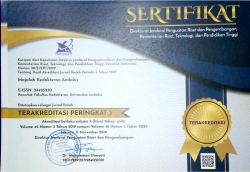Pengaruh Pemberian Mesenchymal Stem Cell Wharton’s Jelly (MSC-WJ) Terhadap Ekspresi Gen IL-1β dan Ryr3 Pada Tikus Model Alzheimer’s Disease
Abstract
Tujuan penelitian ini adalah untuk menganalisis pengaruh dari Mesenchymal Stem Cell Wharton’s Jelly (MSC-WJ) terhadap ekspresi gen IL-1β dan Ryr3 pada otak tikus sebagai hewan model Alzheimer’s disease. Metode yang digunakan untuk mendeteksi ekspresi gen IL-1β dan Ryr3 dilakukan secara kuantitatif menggunakan Real-Time PCR. Hasil pemeriksaan ekspresi gen IL-1β menunjukan ekspresi gen IL-1β pada kontrol lebih rendah dibandingkan dengan hewan model perlakuan yang diinduksi AlCl3 yaitu sebesar 13%, sedangkan tikus yang diberikan treatment MSC-WJ setelah diinduksi dengan AlCl3 menunjukan ekspresi gen yang lebih tinggi dibandingkan dengan tikus yang hanya diinduksi dengan AlCl3 saja yaitu sebesar 66%. Hasil pemeriksaan ekspresi gen Ryr3 pada kontrol menunjukan ekspresi gen Ryr3 lebih rendah dibandingkan dengan hewan model perlakuan yang diinduksi AlCl3 yaitu sebesar 52%. Tikus yang diberikan treatment MSC-WJ setelah diinduksi dengan AlCl3 menunjukan ekspresi gen yang lebih rendah dibandingkan dengan tikus yang hanya diinduksi dengan AlCl3 saja yaitu sebesar 69%. Kesimpulan dari penelitian ini yaitu Mesenchymal Stem Cell Wharton’s Jelly (MSC-WJ) tidak memberikan pengaruh yang signifikan terhadap ekspresi gen IL-1β dan memberikan pengaruh berupa penurunan yang signifikan terhadap ekspresi gen Ryr3 pada tikus model Alzheimer.
Keywords
Full Text:
PDFReferences
Abid NB, Naseer MI and Kim MO. 2019. Comparative Gene-Expression Analysis of Alzheimer’s Disease Progression with Aging in Transgenic Mouse Model. International Journal of Molecullar sciences. 20: 1-14.
Alicka M and Krzysztof M. 2018. The effect of chronic inlammation and oxidative and endoplasmic reticulum stress in the course of metabolic syndrome and its therapy. Stem Cells International. 1-14.
Beeravolu N, McKee C, Alamri A, Mikhael S, Brown C, Perez-Cruet M. 2017. Isolation and characterization of mesenchymal stem stromal cells from human umbilical cord and fetal placenta. J Vis Exp. 1-13.
Brisac C, Francois T, Arnaud A, Isabelle P, Florence CG, Catherine B, Christophe L and Bruno B. 2010. Calcium flux between the endoplasmic reticulum and mitochondrion contributes to poliovirus-induced apoptosis. Journal of Virology. 84(23): 12226-12235.
Chen YC, Chang YW, Tan KP, Shen YS, Wang YH and Chang CH. 2018. Can mesenchymal stem cells and their conditioned medium assist inflammatory chondrocytes recovery. Plos One. 13(11): 1-16.
Chung KM, Jeong EJ, Park H, Kyu An H, Woon Yu S. 2016. Mediation of Autophagic Cell Death by Type 3 Ryanodine Receptor (Ryr3) in Adult Hippocampal Neural Stem Cells. 10: 116.
Dewin N dan Gondhowiardjo S. 2013. Stem cell pada kanker. Journal of the indonesian radiation oncology society. 4(1): 4-7.
Fachrurrazy, Susiolwati R and Soejono SK. 2005. Perubahan jumlah sel purkinje cerebellum dan koordinasi motorik akibat pemberian alkohol pada tikus. Berkala Neurosains. 6(1): 27-36.
Gong S, Su BB, Tovar H, Mao C, Gonzalez V, Liu Y, Lu Y, Wang KS and Xu C. 2018. Polymorphisms Within RYR3 Gene Are Associated With Risk and Age at Onset of Hypertension, Diabetes, and Alzheimer’s Disease. American Journal of Hypertension. 31(7): 818-826.
Kristianingrum YP, Widyarini S, Kurniasih, Sutrisno B, Tabbu CR dan Sugiyono. 2016. Jurnal Sains Veteriner. 34 (1): 84-91.
Lee EJ, Nayra C, Diana A, Jacobo S, John S, Paola A, Yating P, Jordan B, Seyed N, Ana M and Mauricio R. 2020. Mesenchymal stem cells reduce ER stress via PERK-Nrf2 pathway in an aged mouse model. Asian Pacific Society and Respirology. 1-10.
Livak KJ & Schmittgen TD. 2001. Analysis of relative gene expression data using realtime quantitative PCR and the 2-δδct method. Methods. 25:402–408.
Louro LA, Valle CZ, Junior AJ, Santos GN, Gubert F, Figueiredo AB, Torres AL, Parades BD, Teixeira C, Moll FT, Otero RM and Santiago MF. 2014. Distribution of mesenchymal stem cells and effects on neuronal survival and axon regeneration after optic nerve crush and cell therapy. Plos One. 9(10): 1-16.
Lykhmus O, Koval L, Voytenko L, Uspenska K, Komisarenko S, Deryabina O, Shuvalova N, Kordium V, Ustymenko A, Kyryk V and Skok M. 2019. Intravenously injected mesenchymal stem cells penetrate the brain and treat inflamation-induced brain damage and memory impairment in mice. Frontiers in Pharmacology. 10(355): 1-12.
Paladino FV, Rodrigues J, Silva A and Goldberg AC. 2019. The Immunomodulatory potential of Wharton’s jelly mesenchymal stem/stromal cell. Stem Cell International.2019: 1-7.
Praveenkumar SE, Bairy KL, Nayak V, Reddy SK, Kiran A and Ballal A. 2019. Amelioration of Aluminium Chloride (AlCl3) Induced Neurotoxicity by Combination of Rivastigmine and Memantine with Artesunate in Albino Wistar Rats. Biomedical & Pharmacology Journal. 12(2): 703-711.
Purba JS. 2020. Potensi terapi sel punca untuk penyakit Alzheimer: Kenyataan atau harapan ?. CDK. 47(1): 1-5.
Putri CF dan Bactiar EW. 2020. Porphyromonas gingivalisdan patogenesis disfungsi kognitif: analisis peran sitokin neuroinflamasi. Cakradonya Dent J. 12(1): 15-23.
Rivera LM, Castrillo SP, Fernandez ML, Fernandez JG, Gonzalez ME, Cosamalon JC and Suarez VV. 2017. Immunomodulation of mesenchymal stem cells in discogenic pain. The Spine Journal. 1-13.
Supnet C, Grant J, Kong H, Westaway D and Mayne M. 2006. Amyloid-β-(1– 42) Increases Ryanodine Receptor-3 Expression and Function in Neurons of TgCRND8 Mice. The Journal of Biological Chemistry. 281(50): 38440-38447.
Syaftel S, Griffin WST and O’Banion MK. 2008. The role of interleukin-1 in neuroinflammation and Alzheimer disease: an evolving perspective. Journal of Neuroinflammation. 5(7): 1-12.
Vania A, Simona L, Anke R, Hugo B, Dante C, Hugo Bes and Rey A. 2006. Expression of IL-1β in supraspinal brain regions in rats with neuropathic pain. Neurosci Lett. 407(2): 176-181.
Wibowo AP, Pramono BA dan Miranti IP. 2017. Korelasi luas area Wharton’s jelly dengan luaran berat lahir bayi pada kehamilan cukup bulan. Jurnal Kedokteran Diponegoro. 6(2): 196-205.





















